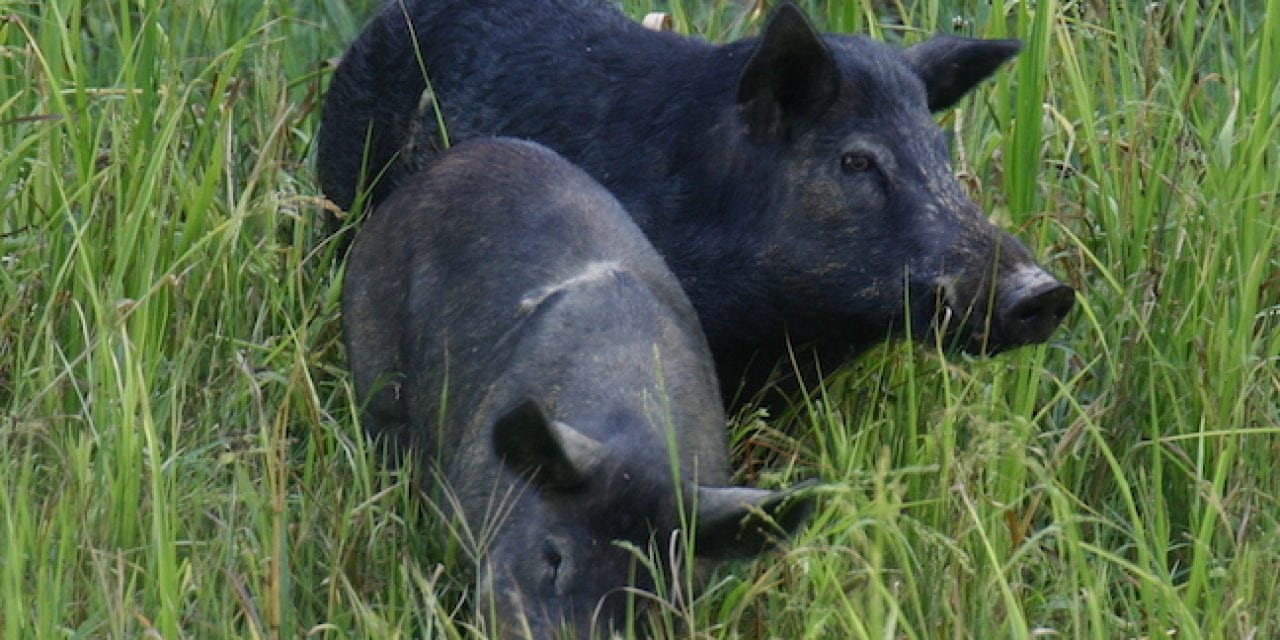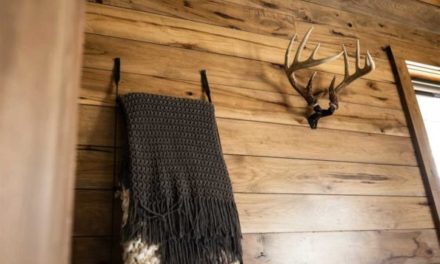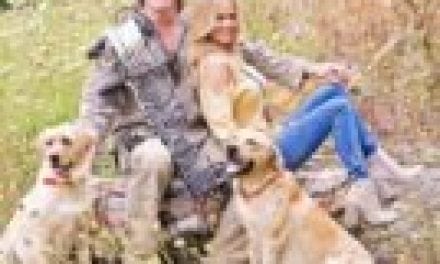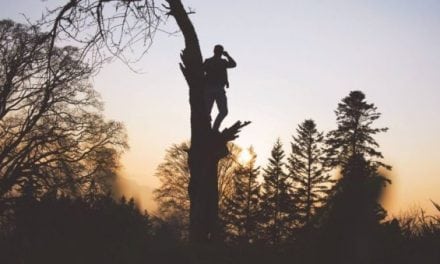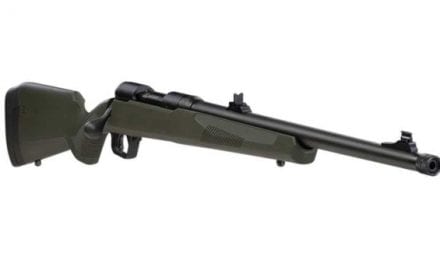Why not add the pursuit of wild hogs to your deer hunting adventures this season?
People in Oklahoma are going hog wild! About getting rid of feral hogs, that is.
Like several other states, Oklahoma is liberalizing laws and regulations and legalizing new methods of hunting and controlling the growing populations of wild hogs that root up crop fields and compete with both livestock and wildlife for food and habitat.
At this writing, while the 2017 Oklahoma Legislature was still in session, a bill to allow hunters to hunt at night from helicopters, and to allow outfitters to take customers on such hunts, has passed the House with a 32 to 12 vote and is being considered by the Senate.
The law would allow pilots to take hog hunters aloft to hunt pigs on commercially licensed hunting areas or on other private lands with the landowner’s permission. It does not allow the airborne hunters to just randomly shoot hogs on lands without landowner permission.
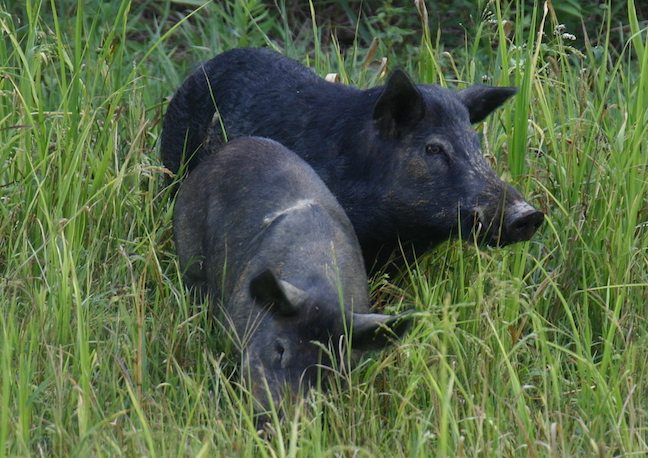
Animal-control agents from state and federal agencies have for many years tried numerous methods of finding and killing feral hogs. (Shutterstock image)
It is similar to a law already passed in Texas where helicopter-equipped outfitters are charging $1,000 an hour or so to take hunters aloft to chase hogs. One of the outfitters there advertises online a two-person, two-hour hog hunt for $3,595. You can even “upgrade to full-auto machine gun” hunts for an additional $395 per person.
The hog-chopper bill is just the latest in the annual expansion of feral hog control measures in Oklahoma. It was introduced, in part, because state agriculture officials didn’t think sport hunting and other control measures were being sufficiently effective in curtailing the expanding feral hog population.
Even an Oklahoma Department of Wildlife Conservation biologist said a few years ago that he believed that hog hunting mostly dispersed hogs and didn’t make a big dent in the population.
Some have even blamed hunters and confined-animal hunting preserve operators for the proliferation of hogs in the state, saying that hunters sometimes trapped, moved and released hogs into new hunting areas and that hunting preserve operators didn’t always keep their “confined” hog populations very well confined.
Trapping wild hogs and selling them to hunting preserves has even been a cottage industry in Southeastern Oklahoma for quite a while, and hogs used to be traded across state lines.
In 2015, though, the state agriculture department issued an emergency order banning the import of feral hogs unless they were bound straight for a slaughterhouse. They said some hogs brought in from Texas had tested positive for brucellosis and pseudorabies.
Not every such piece of proposed anti-hog legislation has been enacted. In 2016 the governor vetoed, with the consensus of our Wildlife Department’s law enforcement division, a law that the legislature approved and would have allowed nighttime hog hunting with spotlights and without specific permission from game wardens.
The wardens, and a couple of wildlife commissioners, opposed that measure saying it would lead to more poaching of other game animals and make it harder to prosecute law breakers.
In vetoing that bill, the governor also issued an executive order directing the Wildlife Department to expedite the permitting process to help landowners eradicate feral hogs, including allowing the use of night-vision equipment for hog shooting at night.
The wildlife commission approved rules in February of this year to comply with the governor’s directive.
State agriculture department agents have already been hunting hogs from helicopters and airplanes and killing them by other measures.
In 2016, the Department reported, agents killed 11,206 pigs, “mostly by air.” That was a 44 percent increase over the previous year. A Department spokesman said the 11,000 pigs was “a drop in the bucket” compared to the number of hogs running wild in pretty much all of Oklahoma’s 77 counties.
Animal-control agents from state and federal agencies have for many years tried numerous methods of finding and killing feral hogs. Some have used what they called a “Judas pig” system, in which they trapped a feral hog and placed a radio transmitter collar on it, then turned the hog loose to go run with its herd. Aerial hunting is a recent development.
Even aerial hunting isn’t always easy, day or night. For seven or eight months of the year, trees and leaves make it virtually impossible to see hogs from above unless they just happen to be out in open areas, and hogs tend to spend as little time as possible out in the open, even at night.
While not every hunter wants to or can afford to harass hogs from the air or use machine guns to do it, plenty of Sooner State hunters go afield regularly to hunt hogs by more conventional means.
Hog hunting isn’t always easy. Hogs are relatively intelligent and wary critters and soon learn to be stealthy and avoid hunters if possible. But their growing numbers mean there are many places where hogs can be found, and there are ways to improve the odds of having a successful hunt.
Some hunters, especially down in Southeastern Oklahoma, use dogs to find and flush hogs in daytime hunting. Typical “coon hound” breeds can make good hog dogs. I’ve heard of everything from bulldogs and mastiffs down to little terriers being used. Some serious hog hunters use both “bay dogs” to locate and chase the animals and “catch dogs” to fight or hold the hogs until the hunters catch up.
Some dog breeders in Southern states specialize in breeding and training hog dogs.
I haven’t heard of any Oklahoma dog breeders engaging in that specialty, but if they’re not doing it already, it’s probably just a matter of time.
Other hunters put out bait stations, much like bear hunters, to entice hogs to come to places where they can be ambushed. I’ve heard of these hunters using restaurant scraps, expired bakery products and similar foods, as well as corn and other grains, to bait hogs. Some Southeastern Oklahoma bear hunters had problems with hogs eating up their bait until they began using bait barrels instead of just dumping bait on the ground.
My son puts out corn for deer, both in feeders and by simply scattering it near his stands, and places trail cameras in the baited areas. His cameras usually capture as many or more pictures of hogs as they do deer. Daytime photos of the hogs are rare, though. Most of the hog pictures are snapped at night with the infrared illumination feature of the cameras.
A friend told me recently of one of his relatives in McCurtain County who uses corn mixed with diesel fuel to draw feral hogs into traps he sets for them in the forest. He said he first used the same kind of corn with which many deer and turkey hunters fill their feeders, but found that birds, squirrels, rabbits, deer, turkeys, raccoons and many other kinds of creatures often ate up the corn before the hogs found it.
Soaking the corn with diesel fuel, he said, keeps most everything else from eating it, but hogs still followed the trails of corn right into the traps.
I was skeptical of such a technique, but after hearing about it I came home and looked online to see if anyone else had heard of it. I learned that quite a few hog hunters and trappers were doing it.
On one forum it was suggested that the hogs also like to roll in the diesel-soaked corn to help them get rid of insect pests on their hides. Another hunter suggested putting squares of old carpet soaked with diesel and used motor oil on the woods floor because hogs would roll on the carpets to get the oils on their hides and would return to do it again and again.
How effective those methods are I couldn’t say, but it is interesting to see what techniques hunters come up with to enhance the odds of bagging hogs.
Stalking hogs on foot by moving slowly through bottomlands or areas with lots of hog sign is generally more productive than hunting from a stand. It can also be frustrating, for hogs are good at hiding during bright daylight hours when they tend to sleep in shady, brushy areas or even snooze in the mud beneath overhanging branches at the edges of ponds and creeks.
TIPS FOR HANDLING PORK
Pork from wild pigs (and farm-raised pigs as well) can be delicious, but because there are diseases that can be transmitted to humans through contact with body fluids of swine, the Center for Disease Control suggests that hunters do the following.
*Wear disposable gloves while field dressing/butchering feral hogs and wash hands and exposed skin with warm water and soap afterward.
*Cook the meat thoroughly to an internal temperature of at least 160 degrees Fahrenheit.
*Thoroughly clean and disinfect knives and other utensils and work surfaces with soap and a water/bleach solution.
The most common disease from swine that is a threat to humans is brucellosis. Its onset, with flu-like symptoms, may not appear for weeks or months after eating contaminated meat. It can be treated with antibiotics.
They can evacuate an area quickly if disturbed, either by charging away at full speed, or slipping quietly through the underbrush.
While quite a few hogs are taken during deer seasons by Oklahoma hunters who happen to get the opportunity, daytime stand hunting is rarely productive. At daylight and dusk you might find hogs coming to a feeder or passing through an area, but the hogs usually move more before and after legal shooting hours for deer.
There are provisions for nighttime hunting, but it is mostly allowed as a depredation control measure and a landowner must apply for the proper permits and permissions.
According to Oklahoma law, permission for night-shooting will be issued only to a “deed-holding landowner or a written designee.” Only one permission will be issued per property. Permission can be obtained from a game warden in the landowner’s county or adjacent county.
Anyone shooting feral hogs at night must carry written permission of the landowner and anyone under 18 must be accompanied by an adult. Someone in the hunting party must also carry a copy of the game warden’s permission document.
Night-vision equipment and/or lights can be used.
The rules for night hunting are rather complex, but they are not intended to make it difficult for hunters to kill hogs. Illegal hunters, deer poachers and their ilk are in part responsible for the detailed regulations. That is because in the past, nighttime deer poachers, when confronted by game wardens or other law enforcement agents, claimed that they were only trying to help thin out wild hog populations.
Complete regulations for nighttime hunting can be found at wildlifedepartment.com. To search for the pertinent information, go to the “hunting” section, then to the “what to hunt” pages, and finally to the “Feral Hogs” pages. The Oklahoma Department of Agriculture and Forestry’s Web site also has extensive information on hog hunting, trapping and other control measures.
If feral hogs are present in significant numbers, it is easy to find tracks, droppings and places where they have rooted up the grass or leaf litter in search of food. In the fall, oak thickets that attract deer looking for acorns will attract hogs too, if there are many around.
Not only do hogs compete with deer for food, but there also are some concerns that they may prey on young deer.
My editor at Oklahoma Game & Fish magazine showed me a photo a few months back that showed a big hog in Louisiana running through the brush with a deer fawn in its mouth.
My son and I, as well as a couple of neighboring ranchers, have seen a decline in deer numbers since the feral hog populations have expanded in our hunting area.
There are a number of professional hunting guides and outfitters offering hog hunts in Oklahoma these days. Guided hog hunts can be a good option for hunters who don’t otherwise have access to a good hunting spot. And “ordinary” hog hunts tend to be less expensive than guided deer hunts.
You can hunt hogs from a half-hour before sunrise until a half-hour after sunset. The Wildlife Department includes a sunrise-sunset table in its rule book each year.
The post Hunting Wild Hogs: New Rules to Control Population appeared first on Game & Fish.

